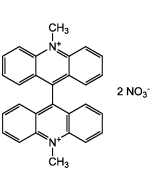Cookie Policy: This site uses cookies to improve your experience. You can find out more about our use of cookies in our Privacy Policy. By continuing to browse this site you agree to our use of cookies.
Chemodex
N,N-Dimethyl-6-propionyl-2-naphthylamine

| Product Details | |
|---|---|
| Synonyms | Prodan |
| Product Type | Chemical |
| Properties | |
| Formula | C15H17NO |
| MW | 227.3 |
| CAS | 70504-01-7 |
| Source/Host Chemicals | Synthetic. |
| Purity Chemicals | ≥98% (HPLC) |
| Appearance | Light yellow powder. |
| Solubility | Soluble in methanol, DMF, acetonitrile or acetone. |
| Identity | Determined by 1H-NMR. |
| Declaration | Manufactured by Chemodex. |
| Other Product Data |
Click here for Original Manufacturer Product Datasheet |
| InChi Key | MPPQGYCZBNURDG-UHFFFAOYSA-N |
| Smiles | CCC(=O)C1=CC2=CC=C(C=C2C=C1)N(C)C |
| Shipping and Handling | |
| Shipping | AMBIENT |
| Short Term Storage | +4°C |
| Long Term Storage | -20°C |
| Handling Advice | Protect from light and moisture. |
| Use/Stability | Stable for at least 2 years after receipt when stored at -20°C. |
| Documents | |
| MSDS |
 Download PDF Download PDF |
| Product Specification Sheet | |
| Datasheet |
 Download PDF Download PDF |
N,N-dimethyl-6-propionyl-2-naphthylamine (prodan) has both an electron-donor and an electron-acceptor substituent, resulting in a large excited-state dipole moment and extensive solvent polarity-dependent fluorescence shifts. When prodan is incorporated into membranes, their fluorescence spectra are sensitive to the physical state of the surrounding phospholipids. In membranes, prodan appears to localize at the surface, although Fourier transform infrared measurements indicate some degree of penetration into the lipid interior. Excited-state relaxation of prodan is sensitive to the nature of the linkage between phospholipid hydrocarbon tails and the glycerol backbone. Tubulin and its hydrophobic surfaces have been probed with the enviroment-sensitive probes prodan. Prodan is also used for the generation of peroxy-oxalate chemiluminescence with H2O2.
(1) B.A. Rowe et al.; J. Phys. Chem. B 110(30), 15021 (2006) | (2) E. Omanovic et al.; Int. J. Environm. Anal. Chem. 85(12-13), 853 (2005) | (3) M. Lin et al.; C. Huie; Anal. Chim. Acta 339(1-2), 131 (1997) | (4) A. Chakrabarti et al.; Biochem. Biophys. Res. Commun. 226, 495 (1996) | (5) P.L.G. Chong et al.; Biochemistry 28, 8358 (1989) | (6) P.L.G. Chong et al.; Biochemistry 27, 399 (1988)






![4-[4'-(2'-Methyl)thiazolyl]phenol](https://adipogen.com/media/catalog/product/cache/60eb5af712bc93baae8d55513bd31b01/i/m/image_315.png)



